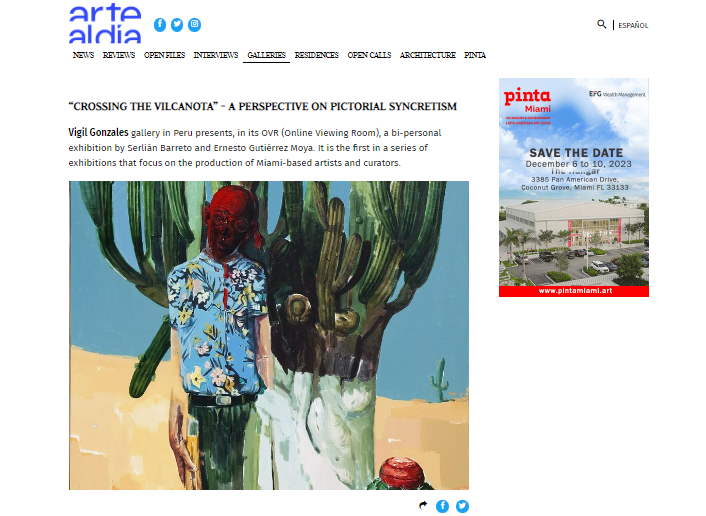News
“CROSSING THE VILCANOTA” – A PERSPECTIVE ON PICTORIAL SYNCRETISM

Vigil Gonzales gallery in Peru presents, in its OVR (Online Viewing Room), a bi-personal exhibition by Serlián Barreto and Ernesto Gutiérrez Moya. It is the first in a series of exhibitions that focus on the production of Miami-based artists and curators.
This exhibition is, above all, a look at a new pictorial perspective. Both Ernesto Gutiérrez Moya (La Habana, 1995) and Serlián Barreto (La Habana, 1997) were trained at the emblematic San Alejandro National School of Fine Arts, in Cuba. The series of paintings exhibited at Vigil Gonzales highlights the cross influences that reside in the visual imaginary of a new generation. An invitation to contemplate a glimpse of the painting that is cooking in the American continent of the 21st century, where multiculturalism and dialogue with a universal visual imaginary proliferate.
Curatorial text written by Tania Hernández (Art Historian, University of Havana):
In the light of a social map where coexistence styles, cultures and dissimilar artistic scenarios converge, symbolic creation practices flourish that continue to bet on painting as a means of transmitting ideas. When it comes to art, a canvas is almost always the image that our mind places by reflex. Over the centuries, images have been superimposed, shapes distorted, figures lost, movement frozen, dreams captured, nature returned and concepts vanished. Different and rugged have been the paths through which painting has traveled, an ancestral artistic medium, universally known by all and that despite technological development, continues to be a protagonist in the art scene, for better or for worse, with lovers or detractors, but current and in constant evolution.
Serlián Barreto and Ernesto Gutiérrez Moya, both of Cuban origin and currently established in Miami, surprise us with attractive and whimsical compositions. They profess a deep love for painting, considering it an intrinsic part of their being and of their daily life. They collect scenes in their minds that are then translated on the canvas through the landscape. Its colors, scenes and themes, at times recall well-known artists but its personal stamp and the mastery of its compositions is undoubted. They share a taste for color, as well as their interest in recreating disturbing solitary scenes that invade us with thousands of unknowns and an intense desire to decipher them from which we cannot escape.
Serlián Barreto moved to the United States in 2019. Since his arrival, the approach to important works of art, that in his student years he had known only through books, had a strong impact on him, becoming sources of inspiration for the work he is developing. It is evident in his work his connection with great masters of painting such as Henri Matisse or David Hockney, the latter not only because of the formal and aesthetic solutions but also because of the themes that he selects. Symbolic and metaphorical, Serlián recreates dark and timeless scenes featuring disconcerting solitude and stillness; fictional landscapes that refer to the most macabre legends of a forgotten world. His canvases are shocked by the force of large planes of color, but what is most disconcerting are the mysterious figures of him and the association of elements that he establishes. Scarecrows, cacti, references to works of art from different cultures, flowers and animals with challenging looks in the middle of a desolate landscape, where the theatricality of the composition is raised, giving way to a hermetic subjective world.
Ernesto Gutiérrez Moya, on his part, likes to break boundaries, developing compositions that move on the border between the figurative and the abstract with a high role in drawing. Moya introduces the viewer to the intimacy of his inner world, in which despite all the coloring, he has a gloomy aura. Moya investigates the mixing processes from the interweaving of techniques that he uses to make his pieces. Interested in the possibilities offered by the different supports, he likes to release all the ideas in the same support, as he himself refers “not being afraid to cover, scrape, or redo something of the painting that I liked as it was, gave me the possibility of enjoying the work more. Putting the whole process on the canvas, seeing all the changes and enjoying the result is unmatched. It is a kind of collage where image and color unify in the end”. This mixture of elements is the charm that captures the viewer who tries to appropriate the enigmatic landscapes that enclose an encrypted story.
As you can well see, these creators, whatever his aesthetic precepts, do not gloat in exclusivist cenacles or resign themselves to classifications. Rather, they seem eager to verify the inevitable updating of the visual universe of their proposals when accessing the international artistic concert. The organicity and fluidity of the composition in both proposals is remarkable, inviting the viewer to unite in their mind, from the abstract, or from the selection of elements, pieces of a puzzle that seem unrelated but that when put together become clear answers to this whimsical mix of images and strokes.
Read more:
https://www.artealdia.com/Galleries/CROSSING-THE-VILCANOTA-A-PERSPECTIVE-ON-PICTORIAL-SYNCRETISM
Spanish version: https://es.artealdia.com/Galerias/ATRAVESANDO-EL-VILCANOTA-UNA-MIRADA-SOBRE-EL-SINCRETISMO-PICTORICO